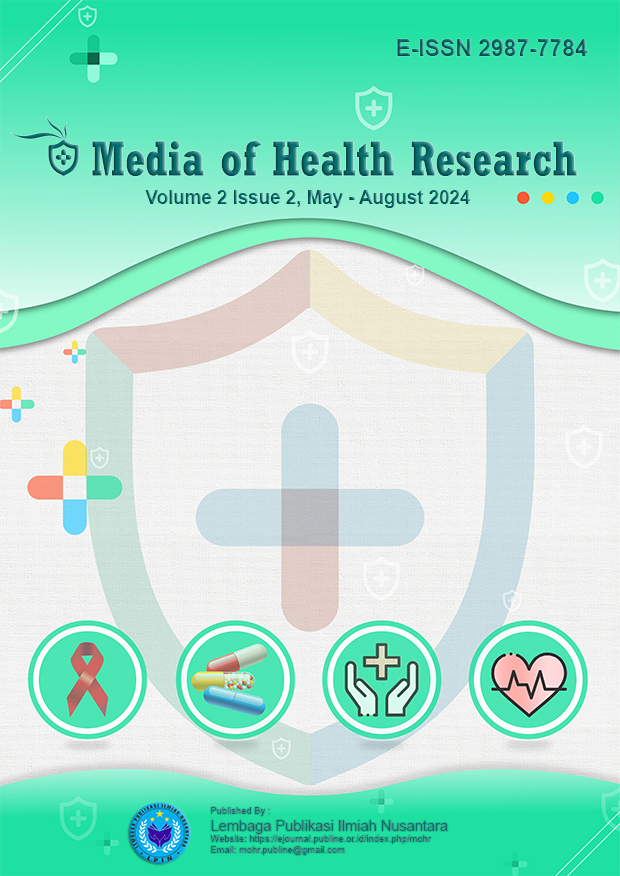Kajian Karakteristik pada Anak Yang Terkonfirmasi Positif Covid-19 di Sumatera Barat Pada Periode Juli-Desember 2020
DOI:
https://doi.org/10.70716/mohr.v2i2.69Keywords:
COVID-19, SARS-Cov-2, ORF, RdRp, Cycle ThresholdAbstract
This study employed a pre-experimental method with a one-group pretest-posttest design. The sample size consisted of 30 respondents. The population included all laboring mothers in the first stage of labor with cervical dilation of 6–8 cm, selected through purposive sampling. Data collection was conducted using counterpressure with a birth ball questionnaires and the Numeric Rating Scale (NRS) for pain measurement. Data analysis was performed using the Wilcoxon test and paired t-test. The Wilcoxon test results showed a Z-value of -4.902 with an asymp.sig (2-tailed) value of 0.000 > 0.05, indicating that the data supports the conclusion that there is a significant difference before and after performing counterpressure with a birth ball. Additionally, the paired t-test revealed that the average pain level before the intervention was 8.20, while the average pain level after the intervention was 6.23. This indicates a reduction in pain intensity with a difference of 1.97, and the significance value obtained was 0.000 > 5% (p-value = 0.000 < 0.05). Therefore, the hypothesis (Ha) is accepted, meaning that counterpressure with a birth ball has a significant effect on reducing labor pain during the active phase of the first stage of labor. The study suggests that counterpressure using a birth ball can be used as an alternative non-pharmacological therapy for pain management during the active phase of the first stage of labor.
Downloads
References
Barman, M. P., Rahman, T., Bora, K., & Borgohain, C. (2020). COVID-19 pandemic and its recovery time of patients in India: A pilot study. Diabetes & Metabolic Syndrome: Clinical Research & Reviews, 14(5), 1205–1211. https://doi.org/10.1016/j.dsx.2020.07.004
Bourgonje, A. R., Abdulle, A. E., Timens, W., & Hillebrands, J. (2019). Pathophysiology of coronavirus disease 2019 (COVID-19). Journal of Pathology: Invited Review, 2. https://doi.org/10.1002/path.5471
Burhan, E., Susanto, A. D., Nasution, S. A., Ginanjar, E., Pitoyo, C. W., Susilo, A., Firdaus, I., Santoso, A., Juzar, D. A., Arif, S. K., Wulung, N. G. H. L., Adityaningsih, D., Syam, A. F., Rasmin, M., & I, C. M. S. (2020). Pedoman tatalaksana COVID-19 (Edisi 3). Perhimpunan Dokter Paru Indonesia (PDPI), PERKI, PAPDI, PERDATIN, IDAI.
Chen, X., Zhu, B., Hong, W., Zeng, J., He, X., Chen, J., ... & Chen, Y. (2020). Associations of clinical characteristics and treatment regimens with the duration of viral RNA shedding in patients with COVID-19. International Journal of Infectious Diseases, 98, 252–260. https://doi.org/10.1016/j.ijid.2020.06.091
Choi, W. S., Kang, C., Kim, Y., Choi, J., Joh, J. S., Kim, G., et al. (2016). Clinical presentation and outcomes of MERS in Korea. Infection & Chemotherapy, 48(2), 118–126. http://dx.doi.org/10.3947/ic.2016.48.2.118
Duan, G. (2020). Intuition on virology, epidemiology, pathogenesis, and control of COVID-19. Novel Research in Microbiology Journal, 4, 955–967. https://doi.org/10.21608/nrmj.2020.118446
Guan, W., Ni, Z., Hu, Y., Liang, W., Ou, C., He, J., et al. (2020). Clinical characteristics of coronavirus disease 2019 in China. The New England Journal of Medicine, 382, 1708–1720. https://doi.org/10.1056/nejmoa2002032
Guru, P., Anak, P., Dini, U., & Jakarta, U. A. (2021). Pengenalan COVID-19 pada anak usia prasekolah: Analisis pada pelaksanaan peran orangtua di rumah. Jurnal Obsesi: Jurnal Pendidikan Anak Usia Dini, 5(1), 315–326. https://doi.org/10.31004/obsesi.v5i1.528
Kannan, S., Ali, P. S. S., Sheeza, A., & Hemalatha, K. (2020). Covid‐19. Africa Research Bulletin: Economic, Financial and Technical Series, 57(2), 2006–2011. https://doi.org/10.1111/j.1467-6346.2020.09549.x
Kumar, M., & Al Khodor, S. (2020). Pathophysiology and treatment strategies for COVID-19. Journal of Translational Medicine, 18, 1–9. https://doi.org/10.1186/s12967-020-02520-8
Li, Q., Guan, X., Wu, P., Wang, X., Zhou, L., Tong, Y., et al. (2020). Early transmission dynamics in Wuhan, China, of novel coronavirus–infected pneumonia. The New England Journal of Medicine, 382, 1199–1207. https://doi.org/10.1056/nejmoa2001316
Sari, M. K. (2020). Sosialisasi tentang pencegahan COVID-19 di kalangan siswa sekolah dasar di SD Minggiran 2 Kecamatan Papar Kabupaten Kediri. Jurnal Karya Abdi, 4(1), 80–83.
Scavone, C., Brusco, S., Bertini, M., Sportiello, L., Rafaniello, C., Zoccoli, A., et al. (2020). Current pharmacological treatments for COVID-19: What’s next? British Journal of Pharmacology, 177(21), 4813–4831. https://doi.org/10.1111/bph.15072
Sethuraman, N., Stanleyraj, S., & Ryo, A. (2020). Interpreting diagnostic tests for SARS-CoV-2. Clinical Infectious Diseases, 71(15), 2019–2021. https://jamanetwork.com/journals/jama/fullarticle/2765837
Shah, S., Singhal, T., Davar, N., & Thakkar, P. (2020). No correlation between Ct values and severity of disease or mortality in patients with COVID-19. Journal of Clinical Virology, 133, 2020–2022. https://doi.org/10.1016/j.ijmmb.2020.10.021
Sheikhzadeh, E., Eissa, S., Ismail, A., & Zourob, M. (2020). Diagnostic techniques for COVID-19 and new developments. Talanta, 220, 121392. https://doi.org/10.1016/j.talanta.2020.121392
Singh, S., Roy, D., Sinha, K., Parveen, S., Sharma, G., & Joshi, G. (2020). Impact of COVID-19 and lockdown on mental health of children and adolescents: A narrative review with recommendations. Psychiatry Research, 293, 113429. https://doi.org/10.1016/j.psychres.2020.113429
Sule, W. F., & Oluwayelu, D. O. (2020). Real-time RT-PCR for COVID-19 diagnosis: Challenges and prospects. The Pan African Medical Journal, 35(Suppl 2), 121. https://doi.org/10.11604/pamj.supp.2020.35.2.4258
Yuki, K., Fujiogi, M., & Koutsogiannaki, S. (2020). COVID-19 pathophysiology: A review. Clinical Immunology, 215, 108427.
Downloads
Published
How to Cite
Issue
Section
License
Copyright (c) 2024 Marli Diana, Harlani Putri

This work is licensed under a Creative Commons Attribution-ShareAlike 4.0 International License.











